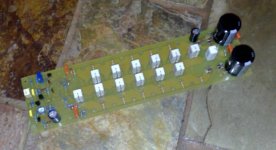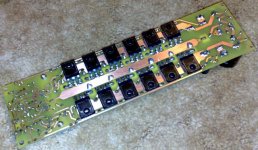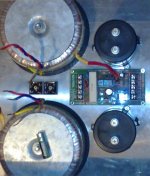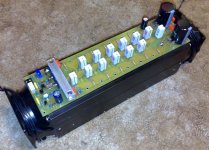The lateral devices are different pinout (GSD) so the PCB would have to be changed to accomodate. Also the bias network would have to be NOT thermally coupled.
Hi Quasi,
on your site you mention that the amplifier (ACTRK600) can be modified quite easily for higher powers,
in particular upping the voltage rating of the driver/VAS and adding a larger output stage.
It would be nice to have 100V rails or greater for PA
can you suggest an easy method to go about doing this ?
what do you think ?
-Dan
on your site you mention that the amplifier (ACTRK600) can be modified quite easily for higher powers,
in particular upping the voltage rating of the driver/VAS and adding a larger output stage.
It would be nice to have 100V rails or greater for PA
can you suggest an easy method to go about doing this ?
what do you think ?
-Dan
Hi AndrewT
Thanks for your reply,
you make it sound so easy!!!
Are you saying - for example replace 2SC1845 with something like - MPSA42 (300V Vce) and MJE340/350 can stay (300V Vce)
and more output stage devices can be added.
I was under the impression you may have to also adjust a few resistor values in the first stages to suit.
What do you think ?
-Dan
Thanks for your reply,
you make it sound so easy!!!
Are you saying - for example replace 2SC1845 with something like - MPSA42 (300V Vce) and MJE340/350 can stay (300V Vce)
and more output stage devices can be added.
I was under the impression you may have to also adjust a few resistor values in the first stages to suit.
What do you think ?
-Dan
danieljw said:Hi Quasi,
on your site you mention that the amplifier (ACTRK600) can be modified quite easily for higher powers,
in particular upping the voltage rating of the driver/VAS and adding a larger output stage.
It would be nice to have 100V rails or greater for PA
can you suggest an easy method to go about doing this ?
what do you think ?
-Dan
As Andrew suggests it basically is about choosing more robust transistors and FETs to do the job. I have built a stereo version of this amp that runs 90 volt rails (to avoid the 100v magic number*) and that runs MJE340 / 350 second stage with 10 x IXFH26N50 per amp module. I have run this amp into 4 ohms in a disco / PA application.
To run 100v rails I suggest 12 of these FETs or similar (IRFP460 etc.) At these voltages the 3 second stage transistors will dissipate around 3.5 watts continuous, so make sure you up the size of the heatsink for these to stop them running too hot. These transistors will be driving into a high total gate capacitance so they will be working fairly hard at higher frequencies.
*100v magic number; Parts become rare and / or expensive after this number, particularly power supply capacitors.
Cheers
Q
The 2SC1845 will never see more than 100 volts (faults excluded) and so will do the job. T1 & T3 are only passing an average of about 1mA so even at this high voltage their work is quite light on.
Because the first stage is current driven most of the resistor values can stay the same. With R7 = 27K the voltage across T2 will rise to just over 50 volts and will dissipate about 0.1 watt. The BC546's Vce is 60 volts so you could increase R7 to 33K to cut T2 a bit of slack.
Cheers
Q
Because the first stage is current driven most of the resistor values can stay the same. With R7 = 27K the voltage across T2 will rise to just over 50 volts and will dissipate about 0.1 watt. The BC546's Vce is 60 volts so you could increase R7 to 33K to cut T2 a bit of slack.
Cheers
Q
Hi Quasi,
Thanks for the advice,
I am building a board to try out for PA / Sub / HiFi / general purpose amp 🙂
do you have any method of how to calculate the max amount of mosfets you can drive from a given VAS ?
I was planning to add more mosfets or higher SOA mosfets to the output stage of the ACTRK600
I was under the impression it was an equation based on Q=1/2CV^2
basically i want find out how many pairs of MOSFETS you can drive of this VAS. or perhaps how to increase the number.
I really like alot of elements in this design for example quasi complimentary design easy to source parts neat / compact discrete driver stage and i was hoping to tweak it for some higher power use.
-Dan
Thanks for the advice,
I am building a board to try out for PA / Sub / HiFi / general purpose amp 🙂
do you have any method of how to calculate the max amount of mosfets you can drive from a given VAS ?
I was planning to add more mosfets or higher SOA mosfets to the output stage of the ACTRK600
I was under the impression it was an equation based on Q=1/2CV^2
basically i want find out how many pairs of MOSFETS you can drive of this VAS. or perhaps how to increase the number.
I really like alot of elements in this design for example quasi complimentary design easy to source parts neat / compact discrete driver stage and i was hoping to tweak it for some higher power use.
-Dan
Good Call AndrewT
useful text:
from the posts:
Ic = C*(dV/dt)
from the white paper
section 1.5 deals with driver current requirements.
i suppose i can do a practical simulation anyhow.
thanks again
-Dan
useful text:
from the posts:
Ic = C*(dV/dt)
from the white paper
section 1.5 deals with driver current requirements.
i suppose i can do a practical simulation anyhow.
thanks again
-Dan
danieljw said:ACTRK600 in progress.......
anyone else building anything similar ????
That looks like really neat work Dan. Seems like you're using high quality parts too 😉
Cheers
Q
ACTRK600 progress.............
yes the parts are good Quasi
12 x IRF460 shoudl make a nice output stage.......
yes the parts are good Quasi
12 x IRF460 shoudl make a nice output stage.......
ACTRK600 supply
2kVA worth of supply:
- 2 x 33,000uF high current caps
- 2 x 1kVA 65-0-65 Vac toroid transformers
- 2 x 35Amp high surge bridge rectifiers
- 1 x power supply "soft start" (Ampslab type)
should be enough for two ACTRK600 boards🙂
note the AA battery for size.
-Cant wait to power it up!
2kVA worth of supply:
- 2 x 33,000uF high current caps
- 2 x 1kVA 65-0-65 Vac toroid transformers
- 2 x 35Amp high surge bridge rectifiers
- 1 x power supply "soft start" (Ampslab type)
should be enough for two ACTRK600 boards🙂
note the AA battery for size.
-Cant wait to power it up!
Attachments
ACTRK600 cooling tunnel....
the cooling tunnel i plan to use for the ACTRK600
with 90% completed board on top - one board of two...
two 80mm ball bearing fans attached. i will set them to low speed for normal use and high speed for +60 deg C.
once again - cant wait to power it up!!!!!!
the cooling tunnel i plan to use for the ACTRK600
with 90% completed board on top - one board of two...
two 80mm ball bearing fans attached. i will set them to low speed for normal use and high speed for +60 deg C.
once again - cant wait to power it up!!!!!!
Attachments
Anyone got a forklift? Looks impressive Dan. Did you clamp the FETs down before you soldered them?
Cheers
Q
Cheers
Q
cheers mate,
yes, i held them flush to the board with some M3 nuts/bolts
there is no movemet/offset (checked the tips in the NMOS350 guide)
- is the bias setup similar to the NMOS 350 guide ?
- yeah fork lift would be handy for this one!
yes, i held them flush to the board with some M3 nuts/bolts
there is no movemet/offset (checked the tips in the NMOS350 guide)
- is the bias setup similar to the NMOS 350 guide ?
- yeah fork lift would be handy for this one!
It is similar, but the thermal behaviour is quite different. This amp varies the bias considerably more then the Nmos350 / 500 and also takes longer to settle when turned on from cold.
Let me know when you're ready to turn it on and we'll go through some detail.
Cheers
Let me know when you're ready to turn it on and we'll go through some detail.
Cheers
Thanks Con, will let you know when its time to see if they make music or smoke.
Andrew, both fans push air in the same direction air enters the sink tunnel at one end and exits the other. i dont really need both to be honest but they hold the two piece heat sink together
-Dan
Andrew, both fans push air in the same direction air enters the sink tunnel at one end and exits the other. i dont really need both to be honest but they hold the two piece heat sink together
-Dan
- Status
- Not open for further replies.
- Home
- Amplifiers
- Solid State
- Another quasi-complementary design



